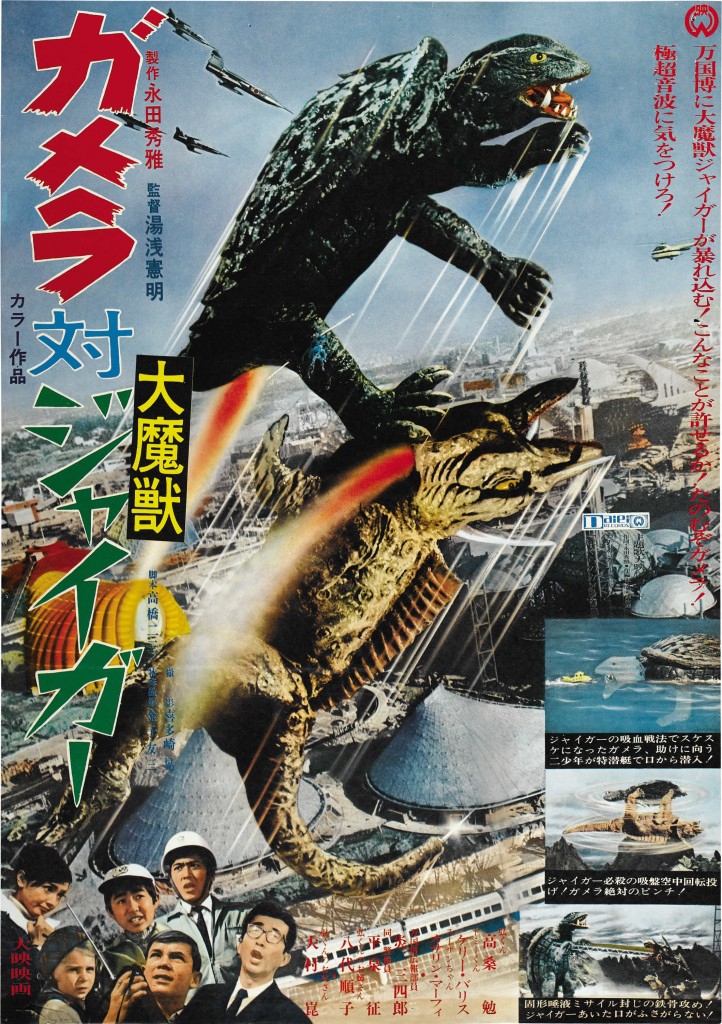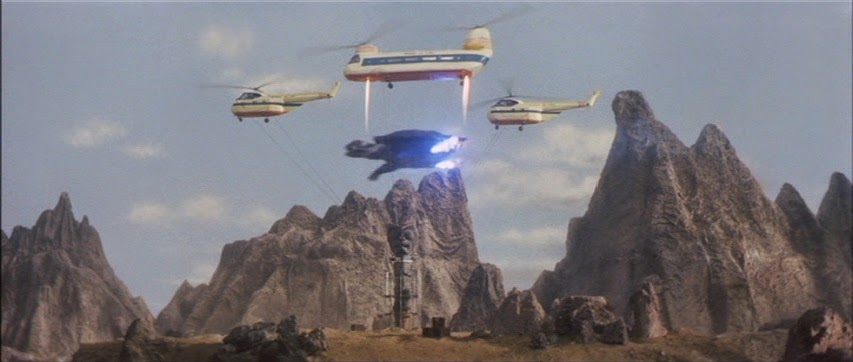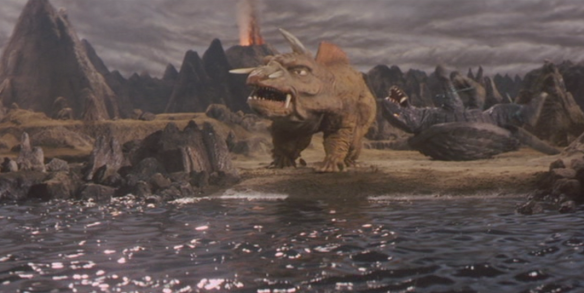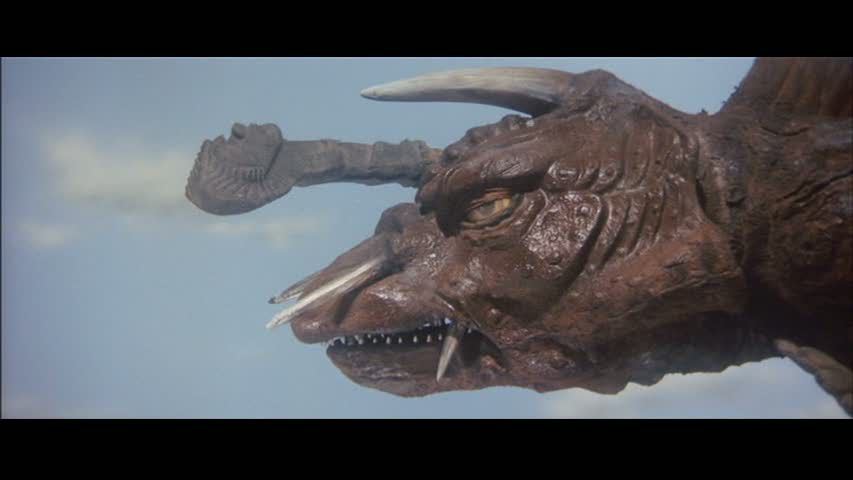Welcome to Angry Turtle!, a series featuring Deadshirt.net’s own Patrick Stinson and guest writer Andrew Tucker. We are going to be looking at the Gamera series, the films made by a rival studio to compete directly with the famous Godzilla series. The name comes from this charming video.
Patrick: Welcome back to Angry Turtle! Our movie this time was Gamera vs. Jiger, the sixth film in the series and a generally well-regarded one.
Andrew: This film centers on a monster revived after mankind removes an ancient pillar from its resting place, thus summoning earth’s protector, Gamera, to rescue the world from its own hubris. Also, there are kids there.
Patrick: This is a much more grounded entry than its predecessor Guiron, a rather abstract if enjoyable film. It also eschews major use of stock footage for the first time since Gyaos. Keep in mind, this is a 1970 film, so the Godzilla series had recently jumped the shark with the epic Destroy All Monsters followed by the kid-focused All Monsters Attack. This was the big kaiju release of the year.
Andrew: Grounded is exactly the word I was going to use to describe this film, despite it involving ancient legends, an odyssey inside Gamera’s body, and of course, the kaiju themselves. It’s interesting that Daiei would choose to go this route, given their emphasis on the more campy science-fiction-style kaiju approach they had been using. Toho, on the other hand, had been struggling with creative shake-ups and declining attendance at this time, so it was Daiei’s game to win here with this release.
Patrick: The most unconventional thing about this film is that it’s heavily based on “Expo ‘70,” a World’s Fair that took place in Japan that year. They actually filmed at the site and the final monster battle takes place on a miniature set of the fair. This dates the film but also is something unique about it, and some of the international titles were along the lines of “Monsters Attack Expo ‘70.” Anyway, that title does a fair job summing up the plot. A team of hasty archaeologists removes the large stone idol “Devil’s Whistle” from its resting place with helicopters, despite some warning flybys from Gamera himself, and promptly a reptilian monster appears out of the ground and starts causing trouble.
Andrew: One of the major themes of this movie revolves around the children trusting Gamera while the adults view him as a threat, which is a bit baffling within the continuity of the series, but it does fit in with the movie as a whole. By setting the movie within the actual “Expo ‘70,” progress and Japan as a positive player on the world stage is at the forefront. Gamera, therefore, could be seen a giant flying yield sign encouraging Japan to reflect on the cost of their progress. The adults, who are blinded by the idea of their discovery, don’t listen to the children who have come to trust Gamera with their lives. This concept of the series’ protagonists distracting the star monsters from its fight with the villainous kaiju is one of the most effective plots that the kaiju eiga uses.
Patrick: To be fair, they learn their lesson pretty quickly, with direct human support for Gamera being a bigger part of their strategy than ever before. In order to talk about this we have to talk about Jiger, who has one of the most eclectic power sets of any monster. While it looks pretty traditional, and even oddly cute, it fires some sort of saliva-spear that punches right through Gamera’s unprotected limbs. It also has a mass-murder heat-and-sound ray that makes it a major threat to cities. It has some sort of ill-defined suction-and-repel power that lets it grab things from far away and take off like a rocket. And finally—almost a decade before Alien—it is a parasitoid monster, injecting Gamera with its own offspring to take him out.
Andrew: It definitely feels like the design team was told, “It shoots spears,” and that’s it, because none of these other powers are reflected in its appearance. That being said, Jiger is one of the best looking kaiju in Daiei’s series. I’ve noticed that they have a tendency to give their monsters abnormally prominent eyes, which in my opinion makes them look goofy. Jiger, on the other hand, looks menacing and appropriately dinosaurian. It also displays intelligence, another hallmark of the Daiei baddies, when it spears Gamera through his limbs for the specific purpose of keeping him from flying. This gives us another chance to weep for Gamera as he pathetically attempts to not only remove the spears but reverse himself after being flipped on his back, a gimmick that I absolutely love every time it’s used.
Patrick: The conflict between Gamera and Jiger feels pretty conventional, but the sequence inside Gamera’s body elevates this, bringing that unconventional imagination that lets this series almost hold its own against the better-produced Godzilla series. This movie’s two kiddos, Toshiro and Tommy (yes, another white kid named Tommy, 2nd in a row) hijack a mini-submarine (shades of Viras) and pilot it right down Gamera’s comatose throat to take out Jiger’s offspring, which has attached to his lung and paralyzed him. Hilariously, baby Jiger looks EXACTLY like Jiger, except I think the horns may be a bit blunted.
Andrew: I noticed that, too. It’s a bit unfortunate that the best-looking suit that Daiei produced up until this point gets put into a scene with actual human beings. This effect diminishes the believability of the suit, as it is no longer sharing screen time with miniatures and another monster. That aside, this provides the kids in the movie to have a legitimate role that doesn’t push the film too far into a “kids movie.” In many respects, it’s an upgraded structure from Gyaos, in which the adults struggle with the over-arching conflict that involves both monsters and culture, while the kid (or kids, in this instance) interact directly with the monsters. There is a hilarious scene, as Gamera loses his bout with Jiger, where the kids rush outside to watch. They are warned of the dangers of running into a giant-monster-infested city, to which their father replies that if Gamera is there then they’ll be fine. As a reminder, we have seen Jiger turn humans into skeletons.
Patrick: All kaiju movies have a challenging time bridging the world of the regular photography and the visual effects photography, which often have completely different directors. When the story and the editing fail to unite them, you get weird disconnects like that. As another example, Gamera’s “x-ray” barely resembles him and looks traced from an X-ray of a real turtle. For this reason I actually like Jigerbaby, as the Gamera movies already failed to use suits that don’t bunch, props that match the suits, or effective high-speed photography in their monster sequences. The gain from making a direct link between the kids’ adversary and Gamera’s outweighed the detriment here.
Andrew: Another thing that stood out to me in this film was the break from the conventional progress of the monster fights. It’s fair to say in most match-ups, the title monster fights the challenger once and loses, has a metaphoric resurrection, and returns to trounce the challenger, sometimes with the help of another monster or humans. Here, Gamera loses when he first encounters Jiger at the excavation site, and then loses again when they fight in the city and Jiger injects him with Jigerbaby. I had been duped into thinking the movie was already coming to a close and then Gamera just collapses and starts going phosphorescent on everyone. I really enjoyed that twist.
Patrick: Gamera’s vulnerabilities remain a key theme. Even during the final battle, Jiger has him on the ropes with her beam. So Jiger–an already conceptually cluttered monster–gets another idiosyncrasy. Turns out that the “Devil’s Whistle” was an actual wind-powered whistle that played a sound that kept her out cold. (This is effectively foreshadowed by mysterious illness among the workers.) The human characters figure out the connection when the kids accidentally kill Jigerbaby with a radio, in a rather breathtaking confusion of radio waves and sound waves.
Andrew: In a movie that includes such an impressive monster weakness as the surprisingly plausible pillar blasting ear-splitting sound, the radio wave thing was distractingly confusing.
Patrick: Yeah there’s really no reason Gamera couldn’t have just…beaten Jiger, but these movies like giving their critters comic-book-style weaknesses. Anyway, in a surprising display of respect, Gamera flies Jiger’s body back to her original resting site for our ending. My thoughts on this movie are the same as they were previously–the strongest late-Showa Gamera has to offer, probably surpassed for me only by Gyaos.
Andrew: I agree completely. This movie is a worthy follow-up to the precedent set by Gyaos’ grounded and social take on the Gamera series, while also including the better aspects of having kids be active protagonists in the plot.
Patrick: Strap yourself in for what’s to come—the last Gamera movie of the ‘70s, Gamera vs. Zigra. You thought you’ve seen cheesy…you thought wrong!
Andrew: I’ll believe that when sharks have legs.







